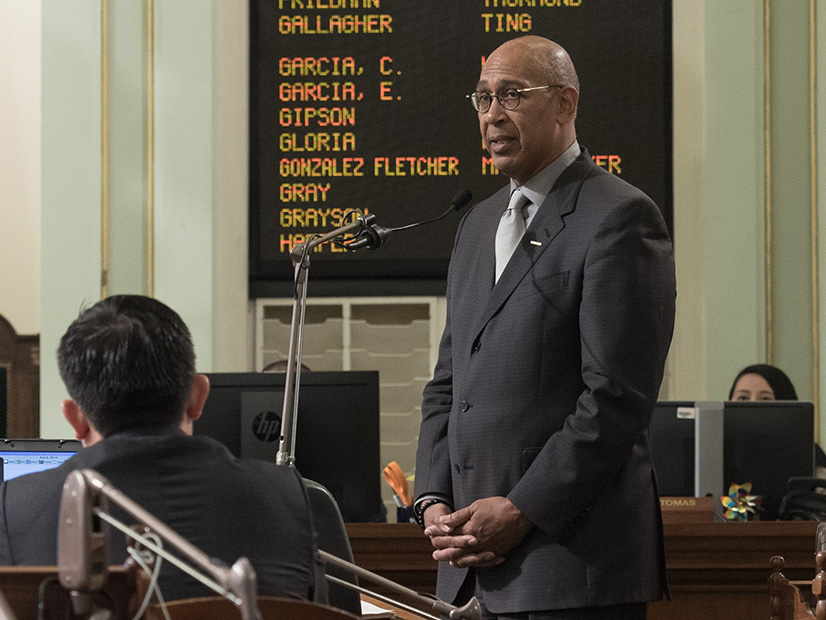
SACRAMENTO, Calif. — A key state lawmaker introduced a bill Wednesday that could eventually transform CAISO into a regional transmission organization with an independent governing body, including members from other Western states.
Assembly Bill 538, by Assemblymember Christopher Holden, would allow CAISO to develop a governance proposal to reach that end, requiring approval from the California Energy Commission and the state legislature. Under the bill, a Western states committee would have an equal number of representatives from states whose transmission owners participate in CAISO. The bill says the committee would “provide guidance” to the ISO on “all matters of interest to more than one state,” but the body’s exact role — including its part in selecting board members — remained unclear Wednesday.
“Centralizing dispatch operations and transmission planning with the rest of the region would significantly enhance electrical reliability and affordability for California households,” Holden, chair of the Assembly Appropriations Committee, said in a statement. “California could go it alone, but then we would be a proverbial energy island. The bottom line is California can reduce cost, ensure we keep the lights on and importantly, achieve our clean energy goals by collaborating with other Western states.”
Holden’s prior efforts in 2017/18, when he chaired the Assembly Utilities and Energy Committee, failed to persuade enough of his fellow lawmakers to relinquish control of CAISO’s Board of Governors, whose five members are appointed by the California governor and confirmed by the state Senate.
Circumstances have changed since then, with strained supply in the West during extreme weather, especially in California. More states, cities and utilities have adopted 100% clean energy goals like California’s, requiring new transmission to move wind and solar power long distances. And two states, Nevada and Colorado, enacted requirements that their major transmission owners join RTOs by 2030.
In addition, CAISO faces competition from SPP, which plans to establish its own Western RTO, and from the Western Power Pool, whose Western Resource Adequacy Program could be a springboard to an RTO.
Last year Holden won unanimous passage of Assembly Concurrent Resolution 188, which asked CAISO to prepare a report for the state legislature summarizing studies of the benefits of regional market participation as a way to restart regionalization discussions.
The report is due to lawmakers by the end of February. A draft report, prepared by the National Renewable Energy Laboratory, cited a range of studies that show significant benefits for California and the West in terms of cost savings, grid reliability, transmission planning and meeting clean-energy goals. (See CAISO Issues Report on Western Regionalization Studies.)
In recent weeks, the movement toward greater regionalization, and calls for one or more RTOs in the West, have grown.
A plan by CAISO to add a day-ahead market to its Western Energy Imbalance Market cleared the Board of Governors and the WEIM Governing Body on Feb. 1. (See CAISO Approves Day-ahead Market for Western EIM.)
On Monday, a group that calls itself Lights on California, said it planned to advocate for California to be part of an RTO and for CAISO to become a regional organization. The coalition’s members include national trade groups Advanced Energy United and the Solar Energy Industries Association, environmental organizations Natural Resources Defense Council and Environmental Defense Fund, and the California Chamber of Commerce. (See New Coalition Aims for California to be in RTO.)
Trust Needed
Advanced Energy United reacted to Holden’s bill introduction Wednesday with a statement that said, “We applaud Assemblymember Holden for his leadership in jumpstarting a thoughtful and action-oriented conversation around regional grid collaboration. California should work with the rest of the West to strengthen energy reliability, affordability and accelerate our progress toward 100% clean energy.
“This is the moment for action. Today, 85% of electricity demand in the West is under a 100% clean goal,” it said. “California should not miss this opportunity to lead the way.”
Vijay Satyal, deputy director of regional energy markets for Western Resource Advocates, said in an interview that the bill represents a “clearer understanding” of the interconnected West.
“It is connected by resources; it is connected for reliability reasons; and a centralized market would enable more resource diversity, bring in more clean energy resources, and strengthen grid reliability,” Satyal said.
The declining cost of renewable power and increasing demand for it means “you are seeing growing momentum to recognize that we need a larger connected market,” he said.
Passing Holden’s bill during the two-year legislative session that began in December will require greater trust among Western states, he said. Prior attempts failed because California did not want to cede partial control of CAISO, and other states, especially those in the more-conservative interior West, were unwilling to let California control a multistate transmission orginization.
“What hopefully will change this time is trust,” Satyal said. “That trust has to be built with a new market structure.”
CAISO declined to comment, saying it had not seen the bill in print yet. Previously CEO Elliot Mainzer said, “There’s a strengthened recognition of the need to work together in the West and the benefits of working together.” CAISO, he said, stood ready to work with Holden on his push for “broader governance reform.”

